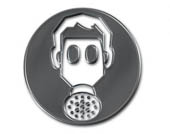
Purpose
To demonstrate how volcanoes give off gas.
Additional information
Magma contains dissolved gases that are released into the atmosphere during volcanic eruptions. Gases may also be released when no eruption occurs from heated magma that remains below the surface. In these cases gas is continuously escaping into the atmosphere from volcanic vents, hydrothermal systems, and fumaroles.
Volcanoes not only spew out lava (molten rock) but they also release several deadly gases that include carbon dioxide, sulfur dioxide, and hydrogen fluoride. Of the three, carbon dioxide is the most common. At low levels of concentration, carbon dioxide doesn't pose much of a threat to humans as it quickly becomes diluted in the atmosphere. However, at certain levels carbon dioxide can become deadly to humans. Since it's heavier than air, the gas can flow into low-lying areas where its concentration can become greater than 30%. Breathing in air of 30% carbon dioxide can result in unconsciousness and even death! In a volcanic eruption there isn't only the danger from molten lava, but also the danger from the poisonous gas. It's estimated that 3% of all volcano related deaths from 1900 to 1986 were a result of volcanic gas.
Sponsored Links
Required materials
- Glass jar
- Bicarbonate of soda (baking soda)
- Vinegar
- Funnel
- Balloon
Estimated Experiment Time
About 10 minutes
Step-By-Step Procedure
- 1. Add some bicarbonate of soda (baking soda) into the bottom of the jar.
- 2. Place your funnel over the mouth of the jar and pour in some vinegar.
- 3. Remove the funnel.
- 4. Place the balloon over the mouth of the jar. What happens to the balloon?
Note
Be careful as your balloon starts to inflate! If it over-inflates it's sure to POP!
Observation
Why do you think the balloon inflated when placed over the mouth of the jar? How is this similar to that of a volcano? Do you think you could modify this experiment to cause a volcanic eruption?
Result
The mixture of bicarbonate of soda and vinegar sets off a chemical reaction that causes gas to rises to the top of the jar. When the balloon is place over the mouth of the jar, the rising gas begins to fill and expand the balloon. This is similar to gas given off by volcanoes. The gases are trapped in cavities (vesicles) in volcanic rocks, dissolved in magma, or released from lava that indirectly heats ground water. These gases continuously travel upward within the volcano.
Sponsored Links
Take a moment to visit our table of Periodic Elements page where you can get an in-depth view of all the elements,
complete with the industry first side-by-side element comparisons!